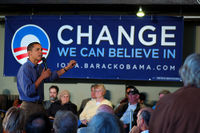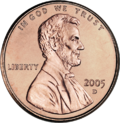Dollar (coin)
The Dollar is a coin minted by Barack Obama and leprechauns for the purpose of communicating to the American people that "if we can't print our way out of a recession, then by-golly we can mint our way out of it!" The new dollar coins are intended to hold their value unlike the evil dollar bill, which as of 2012 is worth less than three-quarters of a eurocent. Contrary to popular belief, the coins are actually made of 99% gold, which is made possible by the scientific achievements of G. Gordon Liddy in the field of alchemy. One percent is made from the remains of the petroleum refining process, making the coins extremely explosive. This unique combustive quality makes the coins ideal for use as fuel in internal combustion engines. With large quantities, given generously by the taxpayers, the coins may one day save the Big Three automakers: Toyota, Audi, and Mitsubishi from bankruptcy, or at least pay for the executives' trip to St. Kitt next spring. Curretly, the largest supply of dollars are found in Duckburg, California in Scrooge McDuck's Money Bin.
The dollar is the first coin in American history that does not have the value depicted in word form. Instead, the symbols 卐KKK are used to identify the denomination.
Other countries have dollar coins, but honestly, who gives a damn?
Disney Character $1 Coin Program[edit | edit source]
Starting in 2009, with the coronation of the Emperor of the Untied States, a series of four coins will be minted each year for the next 200 years, each depicting famous Disney characters in hopes of getting large portions the American population to use the coins instead of Monopoly Money. Previously minted dollar coins depicting old hags haven't been very popular in the United States, though they have been a hit with Jane Fonda. Since old people can't see very well, there have been mass protests over the fact that nobody can seem to find the religious phrase and national motto "Yes We Can" on the coin. Unlike other U.S. coin denominations: the Abrahammy ($0.01), the Jeffry ($0.05), the Roosey ($0.10), the Georgy ($0.25), and the Sumbodyshotmey ($0.50), the national motto is printed on the edge of the dollar coin (dumbass half-blind old people), along with the mint mark and John McCain's Social Security Number. To shut up all the geezers however, starting in 2010, "Yes We Can" will be printed on the obverse of the coin in big fucking 72 point font, Times New Roman. Also, in 2010, the Obama logo will appear on the reverse of the coin with the common Chicago phrase "Pay to Play".
Another complaint over the coins has been with the tendency to lose the golden color after a few days of use. Experiments conducted at CERN have determined that this color change is the result of the looter virus, which as you may remember went rampant immediately after Hurricane Katrina. At night, when everyone is sound asleep, the looter virus attacks and steals the gold, taking it to a secret bunker of an unknown location.
Native Indian Dollar Coins Program[edit | edit source]
Another type of dollar coin has been released in 2009, depicting the contributions of Native Indians to America (ya know, Kwik E Marts and mispronunciations of the word "ball"). A new coin will be released every year (after a ceremonial meditation in honor of Buddha) for the next four years, each with its own theme. The first theme is "Agriculture" and the reverse depicts a baby farm, because everybody knows that the Indians' population is huge and continues to grow thanks to horny Indian men who can't seem to keep their pants on. The front of the coin will obviously depict another old hag; this time it's Hillary Clinton. She is honored on this coin because on her last trip to India, she had to dodge sniper fire, elude an air raid, and defuse a nuclear warhead like she proclaimed in the 2008 Democratic Debate.
See also[edit | edit source]
- Dollar bill, arch-nemesis of the dollar coin


